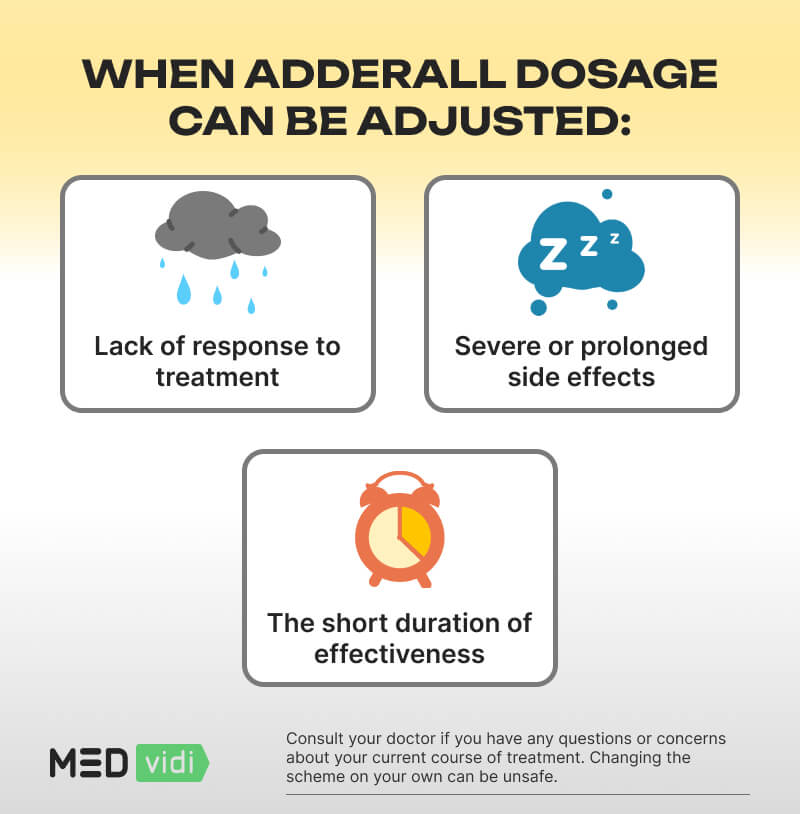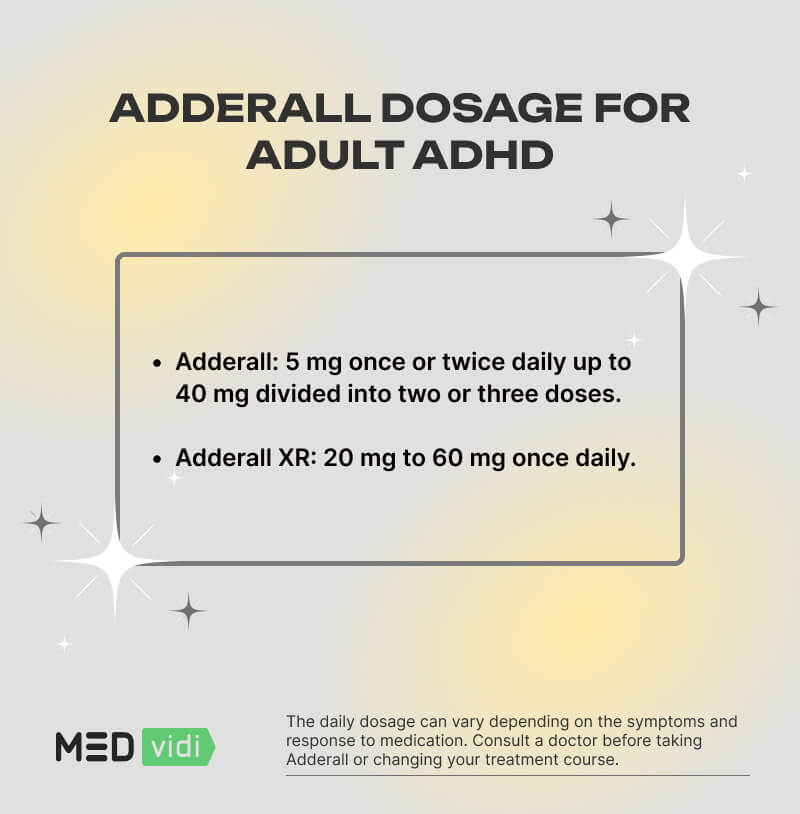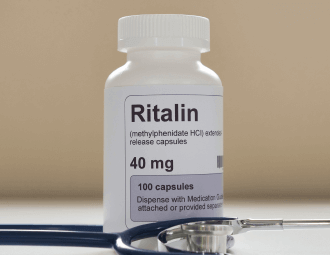Adderall is commonly prescribed to help improve focus, attention, and impulse control in people with ADHD (attention deficit hyperactivity disorder). It falls under the category of controlled substances, so it is only available by prescription. Finding an ideal Adderall dosage is not a one-size-fits-all procedure. A doctor will carefully evaluate the symptoms, medical history, the particular Adderall formulation, and a patient’s personal needs. From this comprehensive guide, you’ll learn more about common and maximum dosages, examine the XR peak chart, and get other helpful insights.
Get your ADHD prescription online.
Adderall: Main Features
Adderall is a prescription medication that belongs to the class of central nervous system (CNS) stimulants. It is commonly used to treat attention-deficit/hyperactivity disorder (ADHD) and narcolepsy. This medication contains a combination of two active ingredients: amphetamine and dextroamphetamine sulfate.
Adderall’s main objective is to regulate and enhance specific brain chemicals (neurotransmitters), especially dopamine and norepinephrine, and boost their availability in the brain. These neurotransmitters play a crucial role in controlling impulse control, focus, and attention. Due to that, medication helps people with ADHD symptoms focus better, control impulsive behavior, and concentrate for longer periods. It may also improve productivity and reduce distractibility, which results in better work and academic performance.
Adderall vs. Adderall XR: Difference
The same medicine, Adderall, is available in two different formulations: Adderall and Adderall XR. Both have unique properties and uses. While Adderall comes in an immediate-release form, Adderall XR is an extended-release version.
- Adderall, being an immediate-release formulation, typically lasts 4 to 6 hours. It has a quick beginning of action after administration, so it is suitable for people who need rapid symptom relief throughout the day. Due to its shorter duration, additional doses could be required to maintain effectiveness. Adderall is prescribed for attention deficit hyperactivity disorder and narcolepsy.
- Adderall XR, on the other hand, is an extended-release formulation designed to provide a prolonged duration of action. It is only prescribed to treat ADHD. Its effects typically last between 10 and 12 hours, and the active ingredients are released gradually over this period. This extended-release technology eliminates the need for numerous administrations, which ensures continuous symptom control with a single daily dose. People who need constant symptom management throughout the day frequently prefer Adderall XR.
Adderall and Adderall XR: Forms and Strength
The decision between Adderall and Adderall XR is based on a number of variables, such as the patient’s response to the medicine and lifestyle requirements. A doctor will also consider convenience, the patient’s personal preferences, and the time needed to control symptoms. Also, available dosages and forms are taken into account.
Criteria | Adderall | Adderall XR |
Strength | 5 mg, 7.5 mg, 10 mg, 12.5 mg, 15 mg, 20 mg, 30 mg | 5 mg, 10 mg, 15 mg, 20 mg, 25 mg, 30 mg |
Form | Tablets | Capsules |
Intake Frequency | Taken several times a day | One daily dose |
Factors That Influence the Choice of Adderall Dosage
Several factors can influence the choice of Adderall dosage. Here are some of them:
- Age. The right dosage of Adderall may vary based on the patient’s age. Dose requirements for children, adolescents, and adults differ due to differences in metabolic and physiological factors.
- Weight. A higher dosage may be necessary to have the desired therapeutic effect in patients with greater body weight.
- Medical history. Adderall may not be a suitable medication for people with heart conditions, high blood pressure, glaucoma, hyperthyroidism, mental disorders, or a history of substance misuse due to its potentially severe side effects.
- Tolerance and response. Over time, some people may become tolerant to Adderall therapeutic effects and require a greater dosage to retain the desired effect. In addition, each person’s response to the drug may differ, and dosage modifications may be necessary to provide the best symptom control.
- Concurrent medications. Some medications may interact with Adderall, including gastrointestinal and urinary acidifying and alkalinizing agents, tricyclic antidepressants, SSRIs, SNRIs, and others. Adderall’s effects may be heightened or diminished in this case, so dosage modifications may be necessary to maintain the optimal therapeutic response.
Adderall XR and Adderall: Safe Dose Range Chart for Adults
Adderall is a federally controlled substance, so it is important to adhere to your doctor’s recommendations to ensure safe use. Patients shouldn’t change the dose without first consulting a doctor. Here is a review of typical dosage options and intake recommendations.
Indication | Suggested initial dose | Maintenance dose | Threshold dose |
Adderall (immediate-release) | |||
ADHD | 5 mg once or twice daily | 20 mg to 40 mg per day, divided into two or three doses. | Not specific |
Narcolepsy | 10 mg daily | 10-60 mg per day in divided doses | Not specific |
Adderall XR (extended-release) | |||
ADHD | 20 mg once daily in the morning is the starting dosage for adults. | 20 mg to 60 mg daily, taken once daily in the morning. | Not specific |
Discuss the ideal dosage of Adderall for your particular situation with the medical professionals at MEDvidi.

Adderall Dosage Compared to Other ADHD Medications
Different ADHD medications have varying dosages and formulations. The right dosage for an individual relies on several variables, including the prescription in question, the patient’s age, weight, and the severity of their symptoms. A basic comparison of dosage ranges for frequently prescribed ADHD drugs is provided here.
Other Stimulant Drugs
Other stimulant medications also increase activity in the central nervous system, resulting in heightened alertness, attention, and energy. These drugs stimulate brain activity and often produce effects such as increased heart rate, elevated blood pressure, improved focus, and a sense of euphoria. These are some stimulant medications prescribed for ADHD.
Drug name | Adult therapeutic dose range | |
Methylphenidate (Ritalin, Concerta) | Immediate-release Ritalin tablets: a safe dose range is from 20 mg to 60 mg divided into 2-3 doses taken per day. | Extended-release formulations (Concerta, Ritalin LA, Metadate CD): dosages range from 18 mg to 72 mg once daily. |
Dexmethylphenidate (Focalin) | Immediate-release tablets: dosages range from 2.5 mg to 10 mg, taken twice daily. | Extended-release capsules (Focalin XR): dosages typically range from 10 to 40 mg, taken once daily. |
Lisdexamfetamine (Vyvanse) | — | Capsules: Dosages range from 30 mg to 70 mg, taken once daily in the morning. |
Non-stimulant drugs
Drugs that are not stimulants are also used to treat ADHD. Although these drugs operate differently from stimulants like Adderall, they are nonetheless capable of controlling symptoms. Depending on the specific non-stimulant drug, different dosages are required. Here are a few non-stimulant drugs that are frequently recommended, along with their average dosages.
Drug name | Adult therapeutic dose range | |
Starting dose | Maximum dose | |
Atomoxetine (Strattera) | The initial dose for adults is usually 40 mg per day. | The dose can be increased gradually based on the individual’s response and tolerability, up to a maximum of 100 mg per day in adults. |
Guanfacine (Intuniv) | The initial dose is typically 1 mg daily, administered orally, usually at bedtime. | The dose can be increased gradually based on the individual’s response, up to a maximum of 4 mg per day. |
Clonidine (Kapvay) | Usually, 0.1 mg per day, divided into two doses. | The dose can be increased as necessary, up to a maximum of 0.4 mg per day. |
How to Take Adderall
Since there are different forms, strengths, and intake rules for Adderall, patients should follow the personalized recommendations mentioned in the prescription. It is also advisable to ask all the questions about taking this medication during an appointment and make notes.
The following are some general recommendations when using Adderall:
- Instructions. Read the medication guide or the pharmacy’s information very carefully. It will include crucial information about the medication, such as dose guidelines, any adverse effects, and precautions to be aware of.
- Dosage. Observe your doctor’s dosage recommendations. The dosage can change based on your condition’s severity, age, weight, and other variables.
- Timing. Use Adderall as directed, typically in the morning. Due to its stimulating qualities, using it late in the day can disrupt your sleep patterns.
- Swallowing. Drink some water and swallow the whole tablet or capsule. The way you consume the extended-release capsules or tablets could be impacted if you chew, crush, or break them.
- Food and drinks. Adderall can be taken with or without food. However, avoid taking it with acidic beverages like orange juice since it could lessen the medication’s effectiveness.
- Regular use. Regularly take Adderall as directed by your doctor. It’s crucial to adhere to the recommended regimen and not change the dosage or frequency without first consulting your doctor.
- Monitoring. Observe your symptoms, adverse reactions, and medication response in general. When you and your doctor are talking about your progress during follow-up appointments, this information will be helpful.
Keep in mind that this is simply general advice, and it’s crucial to speak with a healthcare provider to get detailed instructions based on your medical background and current state. They can advise you on the right dosage, drug interactions, safety concerns, or contraindications.
Modifying Dosage Levels
Sometimes, the initially chosen Adderall dosage needs to be changed. It can happen if the dose is too low, too high, or not effective for a particular patient. These aspects are examined during follow-up appointments with a healthcare professional. The following factors can influence the decision to adjust the dosage to efficiently treat symptoms while minimizing negative effects.
- Response to treatment. The medical expert will evaluate the patient’s reaction to the medicine, considering symptom improvement, tolerability, and probable side effects. To gauge how well the treatment is working, they could utilize validated rating scales or ask particular questions. It is typical to first prescribe the lowest effective dose, so a doctor may increase it depending on the results of this assessment. In some other cases, the dosage can be decreased.
- Individual variations. Age, body weight, metabolism, previous response to stimulant drugs, and any pre-existing medical issues can all affect how someone reacts to the medicine. As a result, dose modifications must be made in accordance with each person’s requirements and how a patient tolerates the medication.
- Titration process. Adjusting titration, which refers to gradually raising or reducing the dose, is frequently used in Adderall dosing. This enables meticulous monitoring of the person’s response and aids in determining the lowest effective dose that provides the best therapeutic results. Titration should be carried out gradually at particular intervals to avoid any unnecessary effects.
- Side effects. If an individual experiences intolerable side effects, such as increased heart rate, elevated blood pressure, or significant emotional distress, it’s important to report them to the healthcare professional. These side effects may indicate that the current dosage is too high, and a dose reduction or alternative treatment option may be necessary.
- Treatment goals. Depending on the patient’s treatment objectives, the dosage of Adderall may be changed. For instance, if symptom control is unsatisfactory, an upward dose modification may be considered. Conversely, a dose decrease or drug modification may be necessary if the patient has acceptable symptom control but is troubled by side effects.
It’s important to schedule routine follow-up visits with the medical professional to evaluate the dosage’s continued efficacy. Changes in the person’s condition, age (in the case of children and teenagers), or other circumstances throughout time may necessitate adjustments. The recommended dose can stay effective with regular reevaluation.
It is also essential to keep the lines of communication open with the medical expert. It will be possible to assess the efficiency of the prescribed dose and spot any potential side effects or insufficient symptom control with frequent check-ins. Feedback on the medication’s effects can help to decide whether a dosage adjustment is required.
Prioritize your mental well-being. Your health matters!

Signs Your Adderall Dose Is Too Low
Determining whether your dose is too low is a complex task requiring a healthcare professional’s careful assessment. However, a few signs may suggest your current Adderall dose is insufficient.
Here are some potential indicators:
- Lack of symptom improvement. If you see little to no improvement in your symptoms of ADHD or narcolepsy after using Adderall for some significant period of time, it may be because the dose is too low.
- Difficulty with symptom control. For people with ADHD, Adderall is frequently recommended to improve focus and attention. If you have trouble focusing, staying on task, or maintaining attention even while taking the drug, this may indicate that the dose is insufficient. If you exhibit severe hyperactivity or impulsivity, it may also indicate that you may need a higher dosage.
- The short duration of effectiveness. Some patients may discover that the medication’s effects subside too soon, causing symptoms to relapse before the next dose. It can be a sign that the dose is too low or that a longer-acting formulation might be more appropriate.
- Side effects without symptom improvement. While it is common to have some side effects while taking Adderall, having them without getting the expected symptom improvement may be a sign that your dose is not appropriate.
How Much Is Too Much Adderall?
Taking too much medication within a day or for a more prolonged period can cause Adderall misuse. At the same time, the amount that leads to misuse or constitutes an overdose can vary depending on an individual’s tolerance, weight, and overall health. It’s essential to follow the prescribed dosage and instructions provided by a healthcare professional. Taking more than the recommended amount can increase the risk of an overdose.
The symptoms of an overdose include the following:
- Agitation and restlessness.
- Rapid breathing or difficulty breathing.
- Increased heart rate or palpitations.
- Elevated blood pressure.
- Tremors or muscle twitching.
- Fatigue.
- Severe headache.
- Hallucinations or delusions.
- Confusion or disorientation.
- Nausea, vomiting, or diarrhea.
- Sweating excessively.
- Panic or anxiety attacks.
- Loss of consciousness or seizures.
Note that exceeding the recommended maximum dose can increase the risk of specific side effects, including elevated heart rate, increased blood pressure, anxiety, insomnia, and other potentially serious complications.
Things to Do When You Suspect Adderall Overdose
It is critical to get immediate medical assistance if you believe you may have taken too much Adderall. Moreover, it is recommended to periodically pause drug delivery and monitor if the changes in behavioral symptoms are sufficient or require more continued therapy. Regarding pharmaceutical overdosing, it’s always better to be cautious.
If you believe someone took too much Adderall, call the emergency number (911 in the US) to get help. Tell the operator you believe that a person has an Adderall overdose, and provide them with any pertinent details. Inform the emergency personnel if you know anything about the patient’s health, the dosage of Adderall consumed, or any other important information. They can provide the right medical advice in such a scenario. Follow their instructions until the emergency team arrives to take over the patient.
The Impact of Adderall Dosage on Side Effects
Like any medication, Adderall can have some bothersome adverse reactions. The dosage of Adderall can influence the severity and likelihood of these side effects. Depending on the individual, the impact can be different, but in general, greater doses of Adderall are more likely to cause negative effects than lower doses. The following are a few of the side effects:
- Increased heart rate and blood pressure. Adderall can elevate heart rate and blood pressure. Higher doses may intensify these cardiovascular side effects, raising the risk of various problems relating to the heart.
- Insomnia. Being a stimulant medication, Adderall may prevent you from falling asleep. Higher doses or doses administered later in the day may make it harder for people to fall asleep or stay asleep, resulting in insomnia.
- Nervousness and anxiety. Adderall can increase feelings of nervousness, anxiety, and irritability. Higher doses may exacerbate these symptoms, possibly resulting in agitation, annoyance, or even panic episodes.
- Decreased appetite. Adderall can suppress appetite; higher doses can further reduce the desire to eat. In particular, if the dosage is dramatically raised, this may cause weight loss or insufficient nourishment.
- Gastrointestinal issues. As a result of taking the medication, some people may experience nausea, constipation, or stomachaches. Higher doses might make these gastrointestinal effects more likely or more severe.
- Headaches. Sometimes, Adderall might result in headaches or migraines. The risk or severity of these headaches may be raised with higher doses.
Final Words
In conclusion, figuring out the right Adderall dosage is a difficult procedure that must carefully consider every individual patient’s response and circumstances. Consultation with a licensed medical professional is essential to assess your unique situation, considering age, medical history, and any underlying problems. While Adderall can be very helpful in treating ADHD, it must be used carefully and responsibly because misuse or abuse can have major negative effects on one’s health. It is crucial to determine the proper dosage under medical supervision to maximize the benefits and reduce any potential hazards.
Frequently Asked Questions
What if I miss a dose?
It is typically advised to take medication in the shortest possible time after missing a dose. But if it’s almost time for your next scheduled dose, it’s better to continue your regular dosing plan. Taking a double dose to make up for a missed one can increase the risks of side effects.
How do I know if the dose in my Adderall prescription is too high?
The right dosage of Adderall varies from person to person and is based on things like age, weight, health specifics, and individual reaction to the drug. The usual procedure is for your prescribing physician to start by prescribing the lowest effective dose and increase it gradually while monitoring your reaction and any side effects. Discuss your prescription dosage with your healthcare provider if you have any concerns.
Can you take 20 mg of Adderall twice a day?
The recommended dosage for Adderall immediate-release tablets can range between 5 mg to 40 mg, taken two to three times daily. However, your healthcare professional should decide how much Adderall you should take based on your unique needs and health. To ensure the drug is used safely and effectively, it is essential to adhere to your doctor’s recommended dosage.
What is a good Adderall schedule?
You can create an Adderall schedule that meets your needs with the assistance of your doctor. Adderall is typically used in the morning to prevent any sleep disruptions. The precise dose frequency and timing will vary depending on the formulation (e.g., immediate-release or extended-release) and your unique circumstances. It’s crucial to adhere to the recommended schedule and not alter it without first visiting your doctor.
How do you take Adderall properly?
Follow your doctor’s advice and instruction on the prescription label when taking Adderall to ensure proper dosage. Usually taken orally, with or without food, Adderall is often recommended to be taken in the morning. It’s crucial to swallow the whole pill (unless otherwise instructed) and avoid crushing, chewing, or breaking it. Consult your doctor if you have any questions about how to take your medication.
How long does Adderall last in your system?
Depending on the composition, Adderall’s effects can vary in duration. Extended-release versions of Adderall can last up to 12 hours, whereas immediate-release versions normally last 4 to 6 hours. Remember that even after the effects wear off, the drug may still be found in your system. The precise length of time depends on metabolism, individual variances, and the type of drug test. It is best to share any worries you may have with your healthcare provider, especially if they relate to drug testing or Adderall’s side effects.













